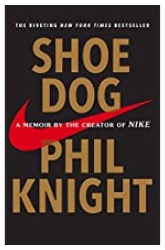This is the final lesson I will draw from Nike, and then we will move on. In the last lesson we reviewed the many problems that Phil Knight faced as he built Nike from the ground up. Today’s lesson is about Knight’s method for overcoming the many problems he faced.
First, I want to restate that he had a number of advantages:
- He had passion.
- He had persistence.
- He had a great team.
But beyond that, he had another weapon in his arsenal that he called “the nightly catechism.”
The Catechism
According to the Oxford English Dictionary, a catechism is “A series of fixed questions, answers, or precepts used for instruction.”
Knight mentioned the catechism twice in his memoir. The first mention was after he found out that the Mr. Katami, his connection at Onitsuka was going to try to cut him out of the business that he had built. His catechism helped him process events and think through what he would do next. This is how he processed his thoughts:
Eventually Penny would look away, watch TV, resume her needlepoint, or read, and I’d retreat to my recliner, where I’d administer the nightly self-catechism.
What do you know?
I know Onitsuka can’t be trusted.
What else do you know?
I know my relationship with Kitami can’t be salvaged.
What does the future hold?
One way or another, Blue Ribbon and Onitsuka are going to break up. I just need to stay together as long as possible while I develop other supply sources, so I can manage the breakup.
What’s Step One?
I need to scare off all the other distributors Onitsuka has lined up to replace me. Blast them right out of the water, by firing off letters threatening to sue if they breach my contract.
What’s Step Two?
Find my own replacement for Onitsuka.
I flashed on a factory I’d heard about, in Guadalajara, the one where Adidas had manufactured shoes during the 1968 Olympics, allegedly to skirt Mexican tariffs. The shoes were good, as I recalled. So I set up a meeting with the factory managers.[i]
Lessons Learned
Knight habitually thought through his problems with his catechism. It is not the only way to think through difficult situations, but it was a good one. The key is that he had a process by which he made sense of his situation. Do you? How do you deal with problems and determine what steps you should take next?
What about you?
Do you have a process to process your problems?
I would highly urge you to read Shoe Dog, Knight’s memoir to get the full story:
References
[i] Knight, P. (2016). Shoe Dog: A memoir from the creator of Nike. New York: Scribner. (p. 179).
___________

Dr. Darin Gerdes is a tenured Professor of Management in the College of Business at Charleston Southern University.
All ideas expressed on www.daringerdes.com are his own.
This post was originally created for Great Business Networking (GBN), a networking organization for business professionals where Dr. Gerdes is the Director of Education.
___________

